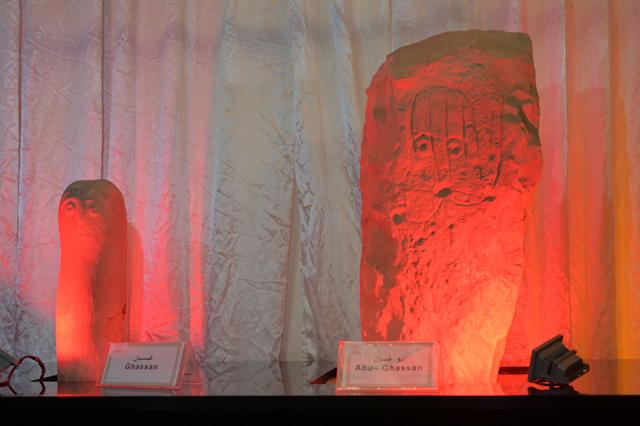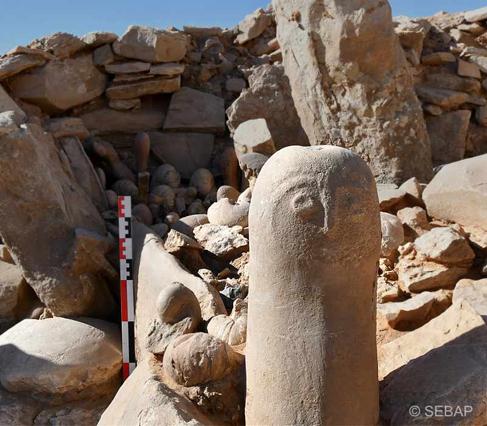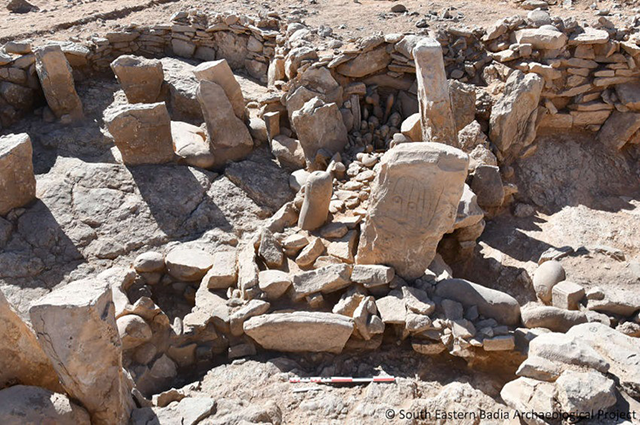You are here
Hunting installation dating back to 7000BC discovered
By Batool Ghaith - Feb 23,2022 - Last updated at Feb 23,2022

Two stones shaped in human forms named Abu Ghassan and Ghassan are displayed during a press conference at the Department of Antiquities in Amman on Tuesday (Photo by Amjad Ghsoun)
AMMAN — Minister of Tourism and Antiquities Nayef Al Fayez on Tuesday announced the discovery of a "unique ritual installation" dedicated to mass hunting of gazelles during the Neolithic period using gigantic traps called “desert kites” in the south-eastern badia by a joint Jordanian-French archaeological team in Al Jafr’s Khashabiyah Mountains.
According to the archeology team, the excavation project started back in 2012, and they recently discovered the installation which consists of the oldest architectural model in the world and the oldest blueprint of “stone traps” dating back to 7000 BC.
It also includes two stones shaped in human forms close to the natural size of humans.
During a press conference at the Department of Antiquities, the archeological team said that the site contains eight kites, extending over 20km from north to south, which is related to the “Ghassanid Occupation” as they used these stone traps to hunt deer and catch animals in semi-circular rooms.
According to the archeology team, the facility also contains a “ritual installation”, which has two standing steles (Abu Ghassan and Ghassan), in addition to an altar, as well as various artifacts, 149 marine fossils, animal dolls, and exceptional flint tools.
The desert kites in Jibal Al Khashabiyeh are in fact the earliest large-scale human built structures worldwide known to date, according to a Tourism Ministry statement.
“Collective hunting was central to the ritual practices of the Ghassanid,” the archeologists said, noting that the significance of the facility lies in the fact it was dedicated for worship.
Fayez, during the press conference, highlighted Jordan as a “cradle of civilisations which continues to amaze the world with new archaeological discoveries, not only at a local scale but also at an international level”.
“The archaeological sites in Jordan have great social, cultural and economic value at national and international levels, as they are an integral part of history, civilisation and identity as well as being touristic attractions,” Fayez continued.
Fayez highlighted the importance of the tourism sector to the Kingdom’s economy, saying: “The Ministry of Tourism strives to develop, rehabilitate, sustain and promote tourist and archaeological sites according to planned studies.”
Ambassador of France in Jordan VeroniqueVouland-Aneini stressed the “fruitful cooperation” between Jordan and France to shed light on the distinguished archaeological sites in the Kingdom.
“I was shocked by the variety and uniqueness of the discovered material in such a remote part of Jordan, where the conditions are particularly difficult for archeologists,” she said.
The ambassador noted that this discovery provides a “priceless testimony of pre-historical life in the Middle East”.
Aneini praised the Jordanian-French bilateral relations in science and culture, pointing out that there are 10 French archaeological missions across Jordan working in various sites dating back to pre-historic periods and up to the Mamluk era.
Director General of the Department of Antiquities Fadi Balawi described Jordan as “an open museum” that contains more than 15,000 archaeological sites.
The “desert kites” are spectacular: Constituted of two or more long walls converging towards an enclosure, these mega structures can reach over several kilometres in length, and they are sometimes organised in chains of contiguous and uninterrupted structures, maximising the potential for wild game capture, the statement said.
Related Articles
AMMAN — The Southeastern Badia Archaeological Project (SEBAP) focuses on late prehistory human developments in the arid margins of the so-ca
AMMAN — A research in the south-eastern desert began in 2013 when the “South Eastern Badia Archaeological Project” was established.In a remo
AMMAN — For archaeological expert Juan Ramón Muñiz, the Spanish Archaeological Mission in Jordan is a symbol of “the cultural friendship tha














